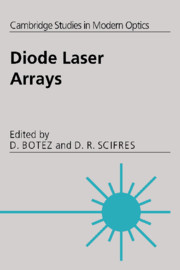Book contents
- Frontmatter
- Contents
- List of contributors
- Preface
- 1 Monolithic phase-locked semiconductor laser arrays
- 2 High-power coherent, semiconductor laser, master oscillator power amplifiers and amplifier arrays
- 3 Microoptical components applied to incoherent and coherent laser arrays
- 4 Modeling of diode laser arrays
- 5 Dynamics of coherent semiconductor laser arrays
- 6 High-average-power semiconductor laser arrays and laser array packaging with an emphasis on pumping solid state lasers
- 7 High-power diode laser arrays and their reliability
- 8 Strained layer quantum well heterostructure laser arrays
- 9 Vertical cavity surface-emitting laser arrays
- 10 Individually addressed arrays of diode lasers
- Index
3 - Microoptical components applied to incoherent and coherent laser arrays
Published online by Cambridge University Press: 10 November 2009
- Frontmatter
- Contents
- List of contributors
- Preface
- 1 Monolithic phase-locked semiconductor laser arrays
- 2 High-power coherent, semiconductor laser, master oscillator power amplifiers and amplifier arrays
- 3 Microoptical components applied to incoherent and coherent laser arrays
- 4 Modeling of diode laser arrays
- 5 Dynamics of coherent semiconductor laser arrays
- 6 High-average-power semiconductor laser arrays and laser array packaging with an emphasis on pumping solid state lasers
- 7 High-power diode laser arrays and their reliability
- 8 Strained layer quantum well heterostructure laser arrays
- 9 Vertical cavity surface-emitting laser arrays
- 10 Individually addressed arrays of diode lasers
- Index
Summary
The preceding chapters of this book have described diode laser arrays with a variety of geometries and coherence properties. Edge-emitting geometries were shown to be capable of high power and high efficiency, whereas surface-emitting geometries permitted fabrication of large two-dimensional arrays. In addition, many of these arrays were designed to contain various degrees of mutual coherence between lasing apertures. In the current chapter, we consider several of the systems aspects of these laser arrays. In particular, we will consider external optical components and systems that manipulate the laser output light to satisfy the requirements of specific applications. We will describe optical systems that act as interfaces between the laser array and other electrooptical components, as well as external laser cavities that improve the performance of the laser array itself.
The recent advances in microoptical components permit unprecedented control of light from laser arrays. Many optical functions are now possible that were previously difficult or impossible to perform with conventional optical components. Microlenses and microlens arrays can be used to collimate and expand individual lasers in an array, making it possible to change the fill factor of a given array. Astigmatism, spherical aberration, and other optical aberrations, can be removed with aspheric and anamorphic microlenses.
- Type
- Chapter
- Information
- Diode Laser Arrays , pp. 123 - 179Publisher: Cambridge University PressPrint publication year: 1994
- 5
- Cited by



